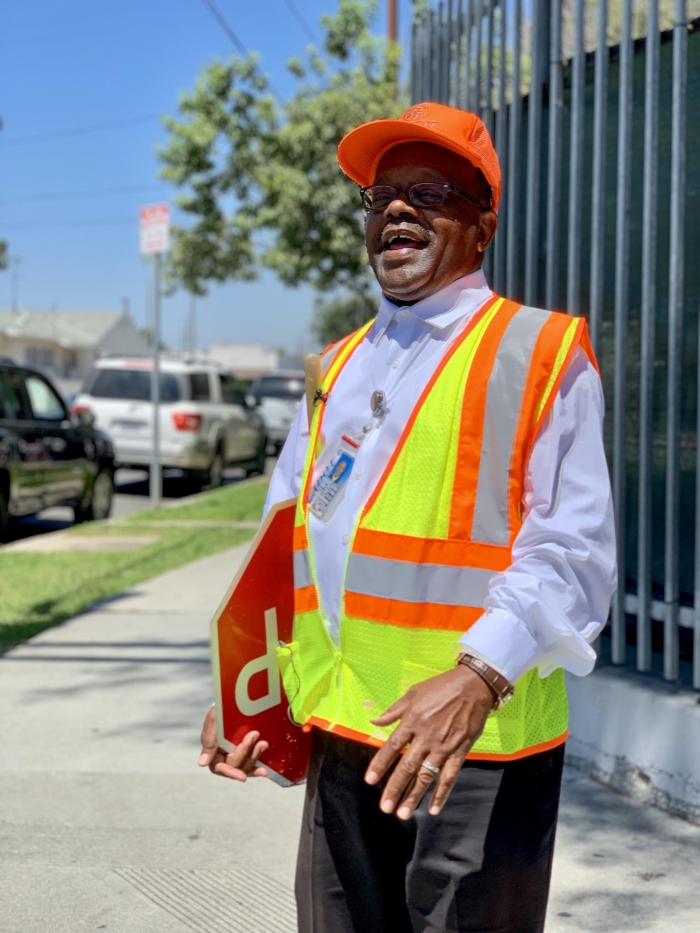
Wednesday, March 3, 1976. It’s a date Carl McCorkle will never forget. That was the day he first began working as a crossing guard for the Los Angeles Department of Transportation (LADOT). He also remembers his first intersection – 11th Avenue and Hyde Park Boulevard, just by the Hyde Park Early Education Center, YES Academy, and Hyde Park Elementary School.
More than 40 years later, McCorkle continues to safeguard children and families as they walk to school each morning. Armed with nothing but an orange cap, a safety vest, a water bottle and a handheld stop sign, he starts his day at 5 a.m. and works until 3:45 p.m. For the past 20 years, he has served as a lead crossing guard in the Watts area, supervising more than 20 other crossing guards and communicating with local schools on a weekly basis.
McCorkle has always enjoyed meeting new people, and over the years, he has become truly embedded in the communities he serves.
“Mr. McCorkle himself has gone through two or three generations of individuals,” said LADOT Lieutenant Carl Jones, who oversees the crossing guard training program. “He gets to know their name; they get to know his name.”
Although the department has implemented new and improved safety measures for pedestrians, such as more signal light locations, more visible crosswalks, and flashing lights, Jones says there is still a great deal crossing guards can bring to an intersection that technology cannot.
“It is extremely important that they have an individual there,” Jones said. “The light is an excellent traffic control device, but the crossing guard provides a personal touch, and it supplies younger people with a contact to understand the rules and the regulations of crossing the street.”
For many children, Jones says, a crossing guard is the first public official they encounter during the day. A crossing guard becomes a familiar face that children come to rely on, especially when they are by themselves.
“I’ve had a parent tell me that it was the first time she ever let her child cross the street by herself, because we had an individual there,” Jones said. “It gave the child a level of independence that she didn’t have before.”
McCorkle, who has raised three children of his own, says his desire to protect children was what drove him to apply to be a crossing guard to begin with.

“I’ve been concerned for the safety of schoolchildren because I’ve experienced people having accidents because they weren’t focused, and they didn’t have a crossing guard,” he said. “They didn’t have anyone to cross the children. So, I felt, ‘Let me apply for this job, and I believe I can help for the safety.’”
Back then, he said, he only expected to do the job for a short while, but he soon discovered a genuine passion and excitement for it. He saw how the schoolchildren looked up to him and felt compelled to continue looking out for them. McCorkle’s unabating dedication has made quite a positive impression on his community, and it’s a quality many of his fellow crossing guards seem to share.
“The years of service are exemplary,” Jones said. “To have someone to perform on the job for 40 years, it takes a special person. It takes a lot of dedication to a job itself. You don’t find that in too many individuals. My crossing guards, including Mr. McCorkle, have exemplary attendance. Crossing guards, for some reason or another, they come to work and they like the job that they’re doing. I have very few crossing guards that don’t like the job.”
Both Jones and McCorkle seek to increase recruitment in the crossing guard training program, particularly to address a shortage of guards in the Valley. According to Jones, there are over 500 intersections in Los Angeles that qualify for a crossing guard, but not all of them are currently manned.
So, what does the crossing guard program have to attract potential trainees? According to McCorkle, there’s good pay and an incredibly supportive work environment.
“We are a family,” McCorkle said. “From the captain, the lieutenant, the sergeant, crossing guard, lead guards, we all are a family including the schools and the students. They have made great things happen with the crossing guard program. I’ve had quite a few [supervisors], but all of them have really been good. It’s been a joy working with the Department of Transportation.”



